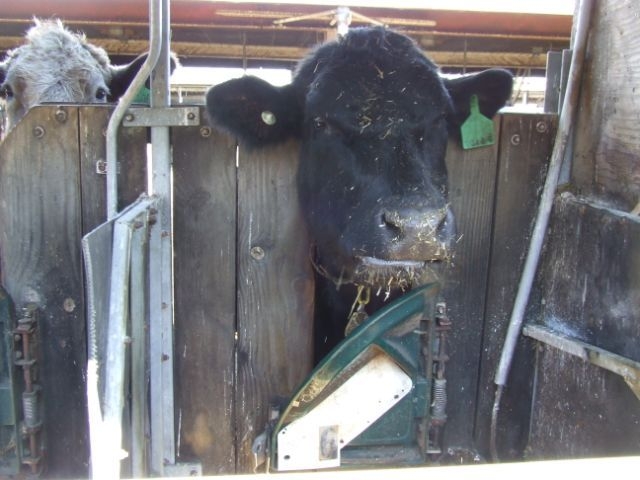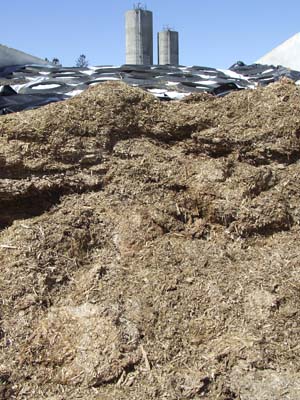As the livestock industry is struggling from increasing financial pressures from the ever rising cost of feed, now more than ever beef cattle producers should consider taking advantage of lower cost forages to minimize feed costs and nutrient wasting. Winter feeding costs represent a large proportion of the total cost of production in the cow/calf industry. More closely matching the nutritional requirements of the cow may yield some significant feed cost savings without influencing the performance of the calf, especially during mid-pregnancy when her requirements are relatively low.
There are numerous lower quality forages that often go underutilized in beef cow rations. Crop residues, including wheat straw and corn stalklage, are much lower in protein, and higher in ADF (acid detergent fibre) and NDF (acid detergent fibre) than good quality hays and haylages. These crop residues are often available for a fraction of the cost of hay/haylage and can be used to dilute high quality forages to closer meet the requirements of the pregnant cow.
Once the beef cow has weaned her calf, her nutrient requirements are relatively low. During this time the nutrient requirements for pregnancy and foetal growth are low and the cow herself needs only to meet basic maintenance nutrient requirements. Often times, with the high quality forages that are often grown in Ontario, cows are receiving excess nutrients, often much more than they require during this period in their production cycle. This may be an opportune time to include some lower quality forages in the ration in order to more closely match the lower nutrient requirements of the mid -gestation cow. However, caution is required in restricting nutrients to the pregnant beef cow. If the cow is restricted to the point where she needs to use body reserves to maintain pregnancy and she looses too much condition, she may have difficulty calving, and may have reduced milk yield, which can result in poor calf performance.
Corn stalklage is similar in nutritional content and fibre digestibility to wheat straw, however, it is underutilized as a potential low quality feedstuff in beef cow rations. Where wheat straw availability for feed uses is sometimes in competition for use as a bedding material, corn stalk material may also be utilized. There has been an increase in corn grain production in recent years which may leave the crop residues from grain corn production available for a potential low quality forage source for cattle.

Figure 1. Cow with neck transponder eating at her individual feedbunk
One of the challenges in utilizing lower quality forages is that cows may not freely consume these crop residues. The use of a TMR mixer can help incorporate crop residues with higher quality forages, but feed sorting still can occur. Feed refusal and excessive feed sorting can negatively impact feed intake, which may have implications on cow and calf performance.
A recent study we conducted at the University of Guelph investigated the use of wheat straw and corn stalklage in TMR rations for pregnant cows. Corn stalklage was harvested from the field after the grain had been harvested, similar to the method used for corn silage, by cutting and chopping the stalks and leaves of the corn plants and ensiling them in a bunker silo. Both the wheat straw and the corn stalklage were added to the ration at 40% (on a dry matter basis), with the remaining portion being a high quality grass/alfalfa haylage. Although the nutritional analyses for the rations containing crop residues were very similar (Table 1), the cows fed the TMR containing stalklage lost body weight and body condition over the feeding period (Table 2). This is likely due to some palatability issues with corn stalklage, resulting in a depression in overall feed intake. Although there were no differences in calf birth weight between the cows fed wheat straw and corn stalklage fed cows, calf weaning weights were lower for cows fed corn stalklage than for cows fed wheat straw. The cows that were fed only haylage had calf weaning weights which were similar to those of cows fed rations containing wheat straw.
Table 1. Diet composition and analyses
Table 1. Diet composition and analyses| Analyseszy | Dietary Treatment | Wheat Straw
Only |
Corn Stalklage Only
|
|---|
Haylage Ration | Corn Stalklage Ration | Wheat Straw
Ration |
|---|
DM, % | 36.7 | 27.4 | 47.6 | 90.5 | 30.2 |
| CP, %z | 18.3 | 11.4 | 11.7 | 4.2 | 4.2 |
| NDF, %z | 49.5 | 63.4 | 64.5 | 82.7 | 81.8 |
| ADF, %z | 42.2 | 51.0 | 50.6 | 56.8 | 56.8 |
z % DM basis. Average of weekly TMR samples. Wheat straw and corn stalklage component samples are average of four samples taken over experiment period.
y DM = dry matter; CP = crude protein; NDF = neutral detergent fiber; ADF = acid detergent fiber

Figure 2. Corn stalklage packed in a bunker silo at Elora Beef Research Center
When we corrected the cow's bodyweight for the weight gain associated with pregnancy (i.e. calf and associated tissue growth), we found that cows that were fed a ration containing corn stalklage lost about 50 kg of body weight on average, while cows who were fed straight haylage gained about 50 kg on average. The cows fed the ration containing wheat straw maintained their bodyweight, gaining only 2 kg on average. Since calf weaning performance was not improved by the excess body weight gain in cows fed straight haylage, we conclude that the ration containing wheat straw more closely met cow requirements without wasting nutrients by building unnecessary cow bodyweight.
Table 2. Cow and calf performance - Dietary Treatments
Table 2. Cow and calf performance - Dietary Treatments| Item | Haylage Ration | Corn Stalklage Ration | Wheat Straw
Ration |
|---|
Cow Average Daily Gain, kg/day | 1.07a | -0.13b | 0.51c |
| Cow Dry Matter Intake, kg/day | 12.8a | 6.7b | 10.9c |
| Cow Change in Body Condition Score z | 0.3a | -0.3b | -0.04c |
| Calf Birth Weight, kg | 43.2 | 44.3 | 44.3 |
| Calf Weaning Weight, kg | 266ab | 253a | 282b |
z Difference between initial BCS and final BCS on a 5 point scale where 1=emaciated and 5=obese.
a-c Values in a given row not sharing the same superscript letter differ (P <0.05)
From this research it is evident that including corn stalklage at 40% (dm) is not advisable since cows lost bodyweight, body condition and had decreased calf weaning weights at time of weaning. However, due to the similar nutrient content to wheat straw, corn stalklage still may have a place in wintering rations for beef cows, but at a lower inclusion level in order to overcome some of the palatability issues and increase feed intake. A wintering pregnant cow diet of 40% wheat straw and 60% haylage (dm basis) fed in a TMR supported calf weaning weights similar to those produced from cows wintered on a straight haylage diet. Wheat straw is a viable feed for inclusion in diets for pregnant beef cows, providing overall diet nutrient levels are adequate. The economics of adding wheat straw to diets will depend on its availability and cost, and access to a TMR mixer.
Source : OMAFRA